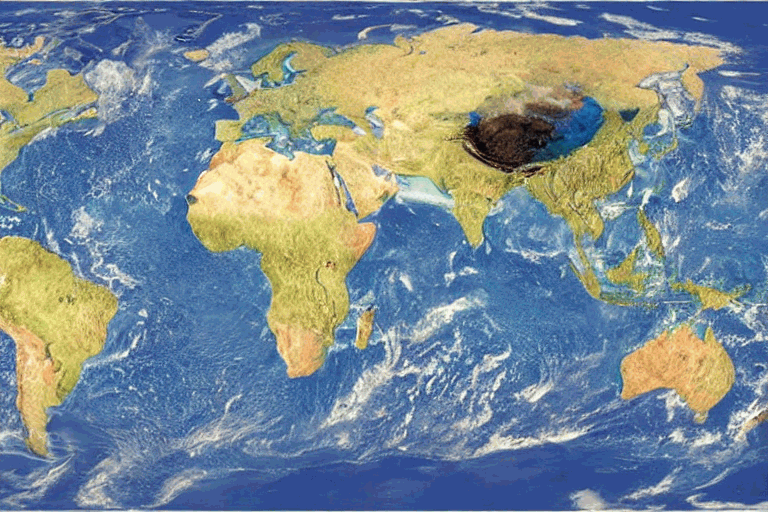The Earth’s face is made up of further than 70 percent water, which is vital to all organisms on the earth.
The world’s biggest water bodies, the abysses, are a mark of transnational pride and are occasionally also called Earth’s lifelines since they give ocean- lanes for transnational trade, piecemeal from furnishing products like seafood as well as marine life itself for fences, faves.
Celebrating these lifelines, the United Nations Organisation( UN) recognized the 8th day of June every time as World abysses Day, since 2008.
Conservation of these gems of Earth is of utmost significance due to global pollution. thus, this World Ocean’s Day, to recognize and celebrate the world’s abysses and give them their due, we’ve collected a list of the world’s top five biggest abysses. Have a look.
01 The Pacific Ocean
The Pacific Ocean is the largest of all the abysses. Its position is between the eastern plages of Africa and Asia and the western plages of the American mainland. It’s also bounded by the Antarctic Ocean in the south and the Arctic Ocean in the north.
The Pacific Ocean extends to about square kilometers and it also has the longest oceanfront that totals roughly 663 kilometers.
Of all the ocean waters, the pacific constitutes roughly 46 and covers further than a third of the total face area. Due to this, it’s larger than the mainland area on the earth’s face combined.
The ambit passes in the middle of the Pacific Ocean and divides it into the South Pacific Ocean and the North Pacific Ocean.
The Pacific Ocean has veritably limited circumstances of damaging ocean currents or movements, which makes it a peaceful ocean.
02 The Atlantic Ocean
The Atlantic Ocean is positioned between the Americas and the European/ African mainland. The Atlantic Ocean is the alternate- largest and saltiest ocean in the world.
It resembles an S- shape between the Americas, Europe, and Africa. “ Atlantic ” began from the Greek god “ Atlas ” who carried the sky for eternity.
The ocean bottom is composed of mid-Atlantic Ridge. This submarine mountain range extends all the way from Iceland to 58 degrees South latitude.
It’s part of the longest mountain range in the world.
The Vikings, Portuguese, and Christopher Columbus have considerably explored the Atlantic Ocean. also to this day, it’s being used for trade routes similar to the transatlantic trade route.
Some of the environmental enterprises include risk marine species similar as seals, manatees, turtles, jumbos, and ocean Napoleons; driftnet fishing which leads to overfishing; external sludge pollution off southern Brazil, easternU.S., and eastern Argentina; oil painting pollution in the Gulf of Mexico, Mediterranean Sea, lake Maracaibo, and the Caribbean Sea; Sewage pollution and artificial waste from the North Sea, Baltic Sea, and the Mediterranean Sea.
03 Indian Ocean
The Indian Ocean is the third largest ocean on the earth. It covers a breadth of about square kilometers. Just like the Atlantic Ocean, the Indian Ocean was largely known as a passage ocean up to the 15th Century that gave it a literal marking for colonization and spice trade.
For this reason, the Indian Ocean has a great record of all feathers of humankind, all the way through world history.
The Indian Ocean is encircled by the eastern seacoast of Africa which constitutes the props of the Middle East and India in the north.
Australia and South East Asia separate the Indian Ocean from the Pacific Ocean. Also, the Indian Ocean has generous fantastic beasts and factory species.
The ocean also makes up around 20 of all the water on the earth’s face and it’s a major ocean route connecting the Middle East, Africa, and East Asia with Europe and America. Up to 40 of all coastal oil painting product is from the Indian Ocean.
Beach beaches are also exploited by the maturity of the countries skirting the Indian Ocean particularly because they’re rich in heavy essence.
The Indian Ocean is as well fairly warm compared to other abysses, which limits the growth of phytoplankton.
colorful anchorages have also been set up along the beachfront of the Indian Ocean videlicet the Port of Singapore and The Mumbai Port. Gulfs, kudos, and we are also multitudinous within the spreads of this ocean.
Some of the environmental enterprises then include risk marine species similar as seals, jumbos, turtles, and dugongs; and oil painting pollution in the Persian Gulf, Arabia Sea, and the Red Sea.
04 The Southern Ocean
In 2000, the Southern Ocean is the newest ocean honored by the International Hydrographic Organization. It borders Antarctica in its wholeness.
In terms of size, it’s the fourth-largest at square kilometers. It extends out to 60 degrees South latitude.
It’s an extreme terrain and is the least understood of the 5 abysses. This is because it’s unexplored, far from populated areas, and has a severe climate.
Despite the Southern Ocean being unexplored, about 80 of all abysses in the world are unexplored. There’s still a lot of work to do for ocean disquisition.
05 The Arctic Ocean
The Arctic Ocean is the world’s lowest and shallowest ocean of all 5 abysses. Further to this, it’s the coldest and least salty ocean.
But over time, glaciers have melted hanging ocean situations to rise.
Despite the IHO feting it as the “ Arctic Ocean ”, some oceanographers still call it the “ Arctic Sea ”.
The Arctic Ocean is the most different in terms of fish species. It has a wide variety of marine species including jumbos, doormats, etc.
But because of its frigid temperatures, it has little factory life. This makes it one of the most fragile ecosystems on the earth.
Final Verdict
There are five oceans in the world. Among them, the big Ocean is called The Pacific Ocean.
Final Word/ Conclusion:
Along with abysses, the Earth has swelled. But there are much further than 7. Swell is girdled by the mainland. For illustration, the mainlands of Europe, Africa, and Asia compass the Mediterranean Sea.

